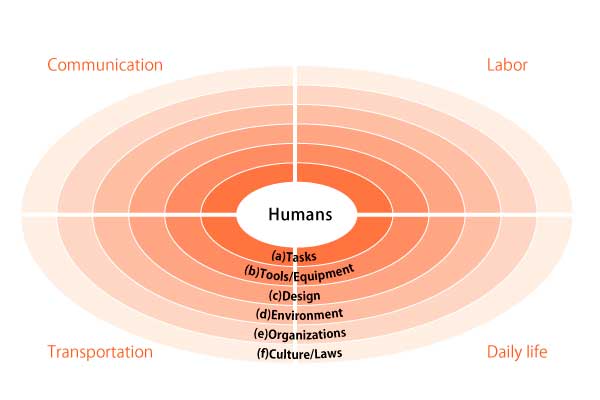Importance of Ergonomics and its Role in Society
To realize a safe, secure and comfortable society and to maintain and promote people’s health
Ergonomics started by scientifically seeking the best and least tiring way to use muscles when working. There are tasks that force people to walk a long way, carrying heavy loads. Keeping the same posture without any alterations can be a factor that causes people to feel fatigued.
Use of ergonomically designed tools or equipment and the introduction of ergonomically formed measures that help to reduce work-related physical strain largely contribute to safety assurance as well as prevention of musculoskeletal disorders such as back pain and increases in productivity. Although the percentage of workers in the first and second industries has kept on declining domestically as the industrial structure changes, back pain currently still accounts for about 60% of work-related disorders (“Study on work-related disorders” by Ministry of Labor, Health and Welfare, 2008). We still have a lot of issues that should be solved by the introduction of ergonomics.
On the other hand, the number of workers in the third industry has rapidly grown since the 1950s, accounting for more than 60% of all workers now. As the industrial structure changes dramatically, the expectation for ergonomics has also changed with time. These days, since people work more with their eyes and brain on a daily basis, eye strain and mental stress are often found in their complaints. Display equipment installed in air planes, cars or control rooms or tools and instruments for controlling output can lead, if inappropriately designed, to huge accidents or disasters. Working forms have been certainly shifting from simple tasks that are high in physical stress to static muscular work with low workload and high constraint such as monitoring or VDT work using computers. Besides taking measures against the increase of these mental workloads at work, in our daily life, we also need to deal with the spread of new types of displays and interfaces that bring us new utility, such as wide screen TVs with 3D function and ubiquitous interfaces. Ergonomics not only plays an important role in establishing smooth interaction in using these appliances (comfortable and effective operation), but also contributes to the harmony and symbiosis of humans, machines and environments.
In short, ergonomics is a practical science that helps us to achieve safety, security and comfort and to maintain and improve our health. Therefore the domains it covers vary significantly.
The figure below systematically shows the domains ergonomics deals with.

Expanding target domains of ergonomics – Systems ergonomics model –
(modified from a slide in “Ergonomics Initiatives at an International Level, 2008” by former president of the IEA, D. Caple)
“Other elements” which are dealt with in ergonomics besides “humans” include “(a) tasks,” “(b) tools/equipment,” “(c) design,” “(d) environment,” “(e) organizations” and “(f) culture/laws.” Combining “these elements ((a) – (f))” with “our various social life scenes” helps us to look at the whole picture of target areas that ergonomics covers.
In workplaces, various kinds of research and practices are handled ergonomically: optimization of work design (a), design of safe tools/machines and measures against excessive workloads (b), design of safe and healthy work environments and workstations (c), measures against heat, noise, vibration and hazardous substances (d), proper setting of working and resting time and shift work schedule (e) and establishment of organizational culture, safety culture and leadership (f). Ergonomics has also played an active part in our daily life and transportation, and helped us to meet the needs of society and solve problems: welfare equipment design or universal design to support aging society (b, c), design of proper classroom equipment and environments adjusted to the growth of elementary school students (b, c, d), application of ergonomics to user-friendly traffic systems for elderly and disabled people (b, c, d) and traffic systems with reduced environmental impact (c, d), and creation of standards for universal access in public transportation (f).
In the sphere of communication, ergonomics has been applied to easy-to-use screens for some software (b) and elderly- and disabled-friendly accessibility guidelines (f), in response to the demand of the information age, serving to eliminate the digital divide in this information-oriented society that becomes more and more sophisticated and multifunctional.
Ergonomics is aiming to realize a safe, secure and comfortable society and maintain and promote your health.
It is always around you and supports your life.






